In today’s fast-paced world, maintaining a healthy diet can be a challenge. Busy schedules often lead to quick, unhealthy meal choices that can derail your fitness goals and overall well-being. This is where healthy meal prep comes in as a game-changer. By referring to healthy meal prep for the week today, you can ensure that you have nutritious options available throughout the week, saving both time and stress.
Why We Need Healthy Meal Prep
Healthy meal prep is more than just a trend; it’s a powerful tool for improving your eating habits and achieving a balanced diet. Here’s why you need to consider making it a regular part of your routine:
- Time-Saving Meals: By dedicating a few hours to meal prep, you save time during the week. This allows you to focus on other important aspects of your life without compromising on healthy eating.
- Portion Control: Pre-portioning your meals ensures you consume the right amount of food, helping to prevent overeating and aiding in weight management.
- Healthy Eating Habits: Consistently having healthy meals ready to go reduces the temptation to opt for unhealthy, fast food options.
- Balanced Diet: Meal prep allows you to plan for a variety of nutrients, ensuring you get a well-rounded diet that supports your overall health.
- Weight Management: With controlled portions and nutritious meals, meal prep is an effective strategy for maintaining or losing weight.
Read more:
How to Start with Healthy Meal Prep
Starting with healthy meal prep can seem daunting, but with the right approach, it becomes a manageable and even enjoyable task. Follow these steps to get started:
1. Plan Your Meals
- Nutritional Needs: When planning your meals for the week, start by considering your specific nutritional requirements. For example, if you’re focusing on weight loss, you might want meals that are lower in calories but high in protein and fiber to keep you full. If you’re an athlete or active person, you may need higher-calorie meals with a good balance of carbs, proteins, and fats.
- Preferences: Tailor your meal plan to your taste preferences. This makes it more likely that you’ll stick to your plan and enjoy your meals. Include your favorite flavors, textures, and ingredients while ensuring they are healthy.
- Dietary Restrictions: Take into account any dietary restrictions, such as allergies, intolerances, or specific diet choices like vegan, gluten-free, or keto. Planning ensures you avoid ingredients that don’t align with your needs and find suitable alternatives.
2. Create a Shopping List
- Organize Your List: After planning your meals, create a detailed shopping list that includes everything you’ll need. Organize it by categories such as produce, proteins, grains, and pantry items. This makes your shopping trip more efficient.
- Prevent Unnecessary Purchases: A well-planned shopping list helps you avoid impulse buys or unhealthy snacks. Stick to your list to ensure you buy only what you need for your meal prep.
- Focus on Healthy Options: Make sure your list includes a variety of fresh vegetables, lean proteins, whole grains, and healthy fats. This helps you create balanced meals that support your health goals.
3. Choose a Prep Day
- Consistency is Key: Selecting a specific day each week for meal prep helps establish a routine. Many people choose Sundays to prep for the week ahead, but any day that fits your schedule will work.
- Flexible Timing: The key is to pick a time when you have a few uninterrupted hours to focus on cooking and organizing your meals. This ensures you’re not rushed and can enjoy the process.
- Make it Enjoyable: Turn meal prep into a fun activity by listening to music, a podcast, or watching a show while you cook. This makes the time go by faster and turns it into a rewarding habit.
4. Gather Containers
- Quality Matters: Invest in durable, high-quality containers that keep your meals fresh. Look for containers that are BPA-free, microwave-safe, and dishwasher-safe for easy reheating and cleaning.
- Portion Control: Consider using containers that are divided into sections to help with portion control. This makes it easier to pack balanced meals with the right proportions of proteins, carbs, and vegetables.
- Variety of Sizes: Having a variety of container sizes is helpful for different types of meals. For example, use larger containers for salads or meals with multiple components, and smaller ones for snacks or sauces.
5. Prep Efficiently
- Plan Your Cooking Order: Start with recipes that take the longest to cook, such as roasting meats or baking grains. While these are cooking, you can prepare quicker items like chopping vegetables or mixing salads.
- Batch Cooking: Whenever possible, cook in large batches. For instance, you can cook a big pot of quinoa or a large tray of roasted vegetables and use them in multiple meals throughout the week.
- Multitasking: Make the most of your time by multitasking. For example, while something is baking in the oven, you can prepare stovetop dishes or snacks.
6. Store and Label
- Proper Storage: After prepping, store your meals in the refrigerator if you plan to eat them within a few days. For meals that won’t be eaten immediately, freezing them is a good option. This keeps your meals fresh and prevents spoilage.
- Labeling: Label each container with the contents and the date it was prepared. This helps you keep track of what needs to be eaten first and avoids the risk of forgetting what’s inside.
- Organize Your Fridge/Freezer: Arrange your meals in an organized manner in your fridge or freezer so they’re easy to grab when you need them. Place meals that need to be eaten sooner at the front.
By following these steps, you can set yourself up for a successful and stress-free week of healthy eating. Meal prep not only saves you time but also ensures you’re nourishing your body with balanced, portion-controlled meals.
Read more:
8 Healthy Meal Prep For The Week
Here are eight delicious and nutritious meal prep ideas that you can easily incorporate into your weekly routine.
1. Overnight Oats
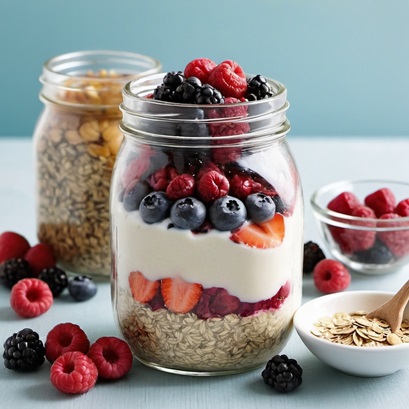
Preparation:
- In a mason jar or container, combine 1/2 cup rolled oats with 1/2 cup milk or a dairy-free alternative.
- Add 1 tablespoon of chia seeds and a drizzle of honey or maple syrup.
- Stir in your favorite toppings, such as fresh berries, nuts, or a dollop of yogurt.
- Seal the container and refrigerate overnight.
Benefits:
- Time-Saving Meals: No cooking is required, making it a quick breakfast option.
- Balanced Diet: Packed with fiber, protein, and healthy fats to keep you full and energized.
- Portion Control: Pre-portioned and easy to customize based on your dietary needs.
2. Grilled Chicken with Quinoa and Veggies
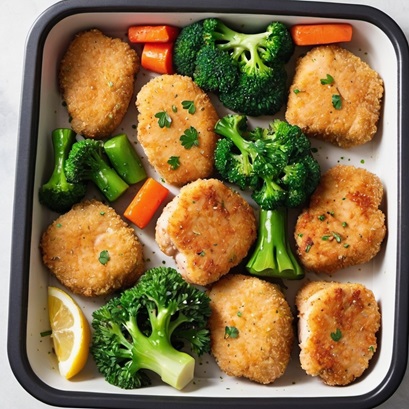
Preparation:
- Season chicken breasts with olive oil, salt, pepper, and your favorite herbs.
- Grill the chicken over medium heat until fully cooked, about 6-8 minutes per side.
- Cook 1 cup of quinoa according to package instructions.
- Steam or roast your choice of vegetables, such as broccoli, carrots, or bell peppers.
- Divide the quinoa, chicken, and veggies into meal prep containers.
Benefits:
- Protein-Rich: Provides lean protein essential for muscle repair and growth.
- Balanced Diet: Includes complex carbs, proteins, and veggies for a complete meal.
- Time-Saving Meals: These can be made in large batches and reheated throughout the week.
3. Salmon with Brown Rice and Broccoli
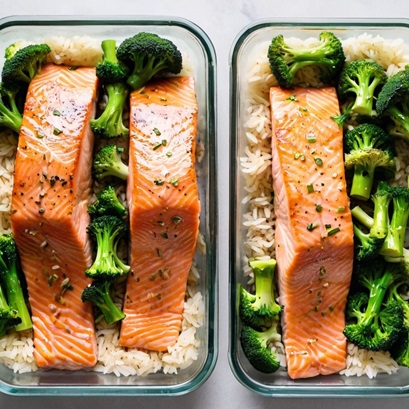
Preparation:
- Preheat the oven to 400°F (200°C).
- Season salmon fillets with olive oil, lemon juice, garlic, salt, and pepper.
- Place the salmon on a baking sheet and bake for 12-15 minutes or until fully cooked.
- Cook 1 cup of brown rice according to package instructions.
- Steam or roast broccoli until tender.
- Divide the salmon, rice, and broccoli into meal prep containers.
Benefits:
- Omega-3 Fatty Acids: Salmon is rich in omega-3s, which support heart health and reduce inflammation.
- Balanced Diet: Combines lean protein, whole grains, and vegetables for a nutritious meal.
- Weekly Meal Planning: Perfect for dinner or lunch options that are easy to reheat.
4. Turkey and Veggie Stir-Fry
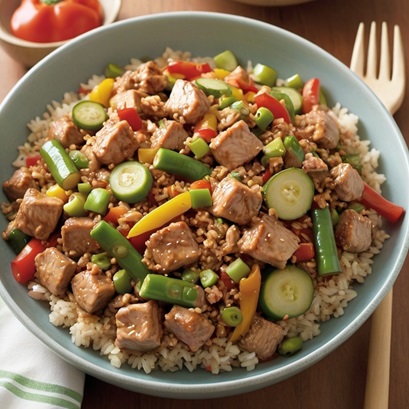
Preparation:
- In a large pan, cook 1 pound of ground turkey over medium heat until browned.
- Add chopped vegetables such as bell peppers, zucchini, and snap peas.
- Stir in a sauce made from soy sauce, garlic, ginger, and a splash of honey.
- Cook until the vegetables are tender and the sauce is well combined.
- Serve over cooked brown rice or quinoa, and portion into containers.
Benefits:
- Low-Fat Protein: Turkey is a lean source of protein, making it ideal for weight management.
- Time-Saving Meals: Stir-fry is quick to prepare and can be easily customized with different veggies.
- Nutrition Tips: Offers a variety of nutrients from the colorful vegetables included.
5. Mason Jar Salads
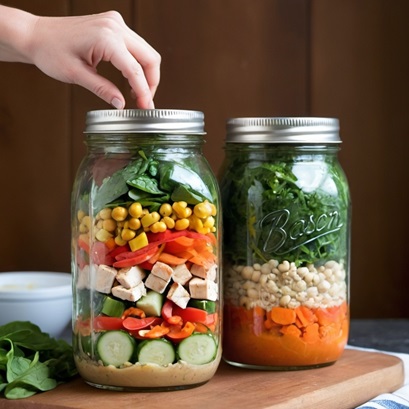
Preparation:
- Start with a dressing at the bottom of the mason jar to keep it separate from the greens.
- Layer hardy vegetables such as cucumbers, carrots, and bell peppers on top of the dressing.
- Add protein like grilled chicken, tofu, or chickpeas.
- Top with leafy greens such as spinach or kale.
- Seal the jar and store it in the fridge until ready to eat. Shake the jar before serving.
Benefits:
- Portion Control: The jar naturally controls portions, preventing overeating.
- Balanced Diet: Provides a variety of nutrients from the layers of vegetables, protein, and greens.
- Healthy Eating Habits: Convenient for on-the-go lunches that keep you on track with healthy eating.
6. Veggie-Packed Frittatas
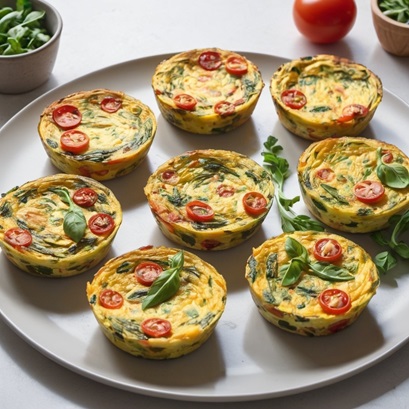
Preparation:
- Preheat the oven to 375°F (190°C).
- Whisk together 8 eggs, salt, pepper, and a splash of milk or cream.
- Add chopped vegetables such as spinach, mushrooms, and tomatoes.
- Pour the mixture into a greased muffin tin or baking dish.
- Bake for 20-25 minutes or until the eggs are fully set.
- Allow to cool before portioning into containers.
Benefits:
- High in Protein: Eggs provide a great source of protein to keep you full and satisfied.
- Time-Saving Meals: Frittatas can be made in bulk and are easy to reheat for breakfast or snacks.
- Balanced Diet: Packed with vegetables for added vitamins and minerals.
7. Homemade Protein Bars
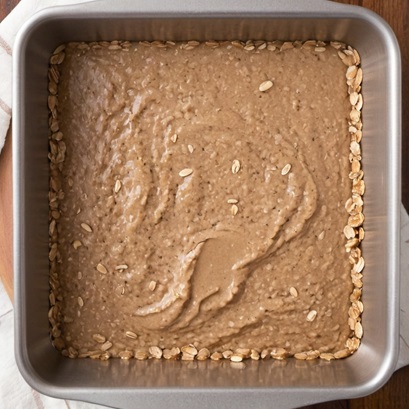
Preparation:
- In a bowl, mix 1 cup of oats, 1/2 cup of protein powder, and 1/4 cup of nut butter.
- Add 1/4 cup of honey or maple syrup and mix until well combined.
- Press the mixture into a lined baking dish and refrigerate for at least 2 hours.
- Cut into bars and store in the fridge or freezer.
Benefits:
- On-the-Go Snack: Convenient for quick, healthy snacking throughout the day.
- Customizable: You can add different flavors or ingredients to suit your taste.
- Nutrition Tips: Provides a good balance of protein, carbs, and healthy fats.
8. Lentil and Vegetable Soup

Preparation:
- In a large pot, sauté chopped onions, garlic, and carrots in olive oil.
- Add 1 cup of lentils, 4 cups of vegetable broth, and your choice of chopped vegetables like tomatoes, spinach, and zucchini.
- Season with herbs such as thyme, bay leaves, salt, and pepper.
- Bring to a boil, then reduce the heat and simmer for 25-30 minutes or until the lentils are tender.
- Divide into containers and allow to cool before refrigerating.
Benefits:
- High in Fiber: Lentils are a great source of fiber, aiding in digestion and keeping you full.
- Balanced Diet: Combines plant-based protein with a variety of vegetables.
- Weekly Meal Planning: Perfect for lunch or dinner, and can be easily frozen for later use.
The Common Mistakes
When it comes to meal prepping, there are a few common mistakes to watch out for:
Over-Prepping
- Food Waste: Over-prepping occurs when you prepare more food than you can realistically eat within the week. This often happens when you’re overly ambitious or when you don’t properly estimate portion sizes.
While the intention is good, the result can be wasted food if meals spoil before you can consume them. Not only does this waste money, but it also negates the time and effort spent on meal prep.
- Avoiding Over-Prepping: To avoid this, start by prepping just a few meals at a time, especially if you’re new to meal prepping. As you become more comfortable, you can gradually increase the amount you prepare. Also, consider freezing some of your meals if you’re unsure whether you’ll get through all of them within the week. Freezing is a great way to preserve food and reduce waste.
Lack of Variety
- Meal Boredom: One of the biggest challenges with meal prepping is sticking to the same meals every week. While it’s convenient to cook in bulk, eating the same dishes repeatedly can lead to taste fatigue, where you become bored with your meals. This boredom can make you less motivated to eat your prepped meals, leading you to seek out less healthy alternatives.
- Introducing Variety: To combat this, plan a variety of meals with different flavors, textures, and ingredients. You don’t need to prepare a completely different meal for each day, but having a mix of dishes can keep things interesting.
For example, you could rotate between different proteins (chicken, fish, tofu) or switch up the types of grains and vegetables you use. Even small changes, like adding a different sauce or seasoning, can make a big difference.
Ignoring Food Safety
- Risk of Spoilage: Proper food safety is crucial when it comes to meal prep. If food isn’t stored or reheated correctly, it can spoil, leading to waste or, worse, foodborne illnesses. Common mistakes include leaving food out at room temperature for too long, not cooling food properly before refrigerating or failing to reheat food to the appropriate temperature.
- Food Safety Practices: To ensure your meals remain safe to eat, always refrigerate or freeze your prepped meals as soon as they’ve cooled down. Don’t leave cooked food out for more than two hours, as this can encourage bacterial growth.
When reheating meals, make sure they reach an internal temperature of at least 165°F (74°C) to kill any potential bacteria. Additionally, use airtight containers to store your meals and label them with the date to keep track of their freshness.
By being mindful of these potential pitfalls, you can make your meal-prepping efforts more effective, enjoyable, and sustainable.
Conclusion
Healthy meal prep for the week is a powerful strategy to maintain a balanced diet, manage your weight.


